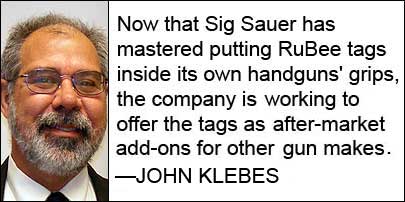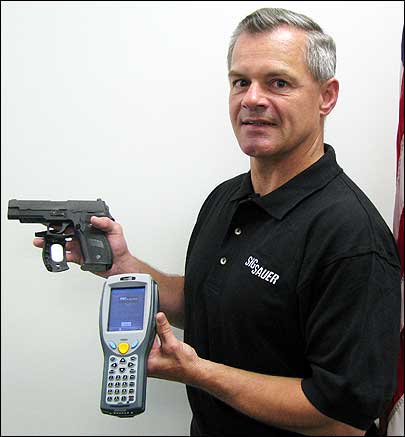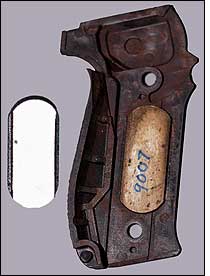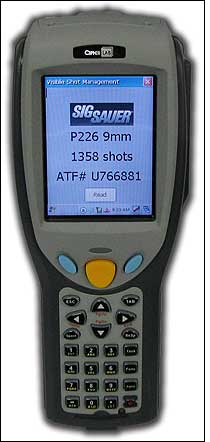Sig Sauer wasn’t thinking about expanding its business. The private Exeter, N.H., company sells the lion’s share of handguns currently used by U.S. federal law enforcement agencies, as well as a third of the guns utilized by state and local law enforcement departments. Sigs are so popular, in fact, they’ve been written into plot lines for several TV shows, such as Law & Order. But a 2007 phone call from Visible Assets, a startup based in Stratham, N.H., that developed RuBee technology, got the handgun manufacturer thinking about new opportunities.
Visible Assets was working with Tennessee’s Oak Ridge National Laboratory, which conducts research and development for the U.S. Department of Energy, to employ RuBee technology—a low-frequency form of RFID—to track weapons used by security guards at the department’s nuclear facilities. But the firm had reached a standstill. Visible Assets mainly sells asset-tracking solutions for medical devices, and required advice from a company that knew something about guns. Since Energy Department security guards carried Sig Sauer handguns, Visible Assets decided to reach out to that company, located just 10 minutes away from the company’s headquarters.
Sig Sauer agreed to join the team. The gun industry, according to Sig Sauer executives, had been seeking a way to improve the error-prone pencil-and-paper system many of its law enforcement customers used to manually check weapons in and out of armories. The industry also needed a more precise method for counting the shots a particular gun fired, to better predict when a weapon needed to be cleaned or repaired.
Sig Sauer, Visible Assets and Oak Ridge collaborated for nearly a year to create the first-of-its kind Weapons Inventory Network, based on RuBee technology. The system provides real-time visibility into weapons’ locations and firing histories, as well as personnel and other high-value assets such as night vision goggles and armored vests.
In February 2008, the partners demonstrated a working prototype of the network at the gun industry’s biggest yearly trade expo, The SHOT Show, held in Las Vegas. Three months later, Sig Sauer and Visible Assets announced the product’s availability. “It’s a game changer,” says Pete Kujawski, Sig Sauer’s VP for military, government and export sales. “This gives us a proprietary edge in the marketplace that our customers would be very interested in.”
The Fellowship of RuBee and Guns
It all started in 2006 when the Energy Department’s Office of Health, Safety and Security (HSS), which is responsible for security technologies used to protect U.S. nuclear complexes, commissioned Oak Ridge to devise a better way to inventory weapons in nuclear facilities’ armories—a process that had become a major headache. HSS armory personnel spent an average of eight hours each day taking inventory of weapons, which added up to approximately $300,000 per year, according to Chris Pickett, a senior R&D staff member and head of the Oak Ridge team. More extensive monthly and annual inventories were costing close to $500,000 annually.
“A lot of times, an armorer is supposed to be on duty at a security post, but he’s doing inventory,” Pickett says. “If we could allow him to do that in minutes instead of hours, you could imagine the cost savings.”
The team had developed RFID-based systems to inventory other materials at government nuclear facilities, so utilizing the technology to track weapons was a logical choice. They tested high-frequency (13.56 MHz) active (battery-powered) and ultrahigh frequency (916 MHz) passive RFID tags, but since metal reflects RF energy, thereby decreasing efficiency, the tags did not work well around guns. The Oak Ridge team also found that some RFID tags weren’t able to withstand the repeated shock that results when a gun is fired.
Pickett researched alternative technologies and discovered RuBee, a low-frequency (132 kHz) wireless technology that’s more RF-friendly to metals and liquids. And since RuBee has a short read range, it would help guard against data transmission leaks that could enable outsiders to know how many guns were kept in that location. The Institute of Electrical and Electronics Engineers (IEEE) made the RuBee protocol a standard (IEEE P1902.1).
A member of the Oak Ridge team contacted Visible Assets’ founder, John Stevens. Scientists and engineers at Oak Ridge and Visible Assets then worked, during the latter half of 2006, at their respective locations figuring out the best way to tag a gun. They also put RuBee tags through a battery of tests to ascertain if they would meet Energy Department performance, durability and security standards.
Eventually, the teams concluded that RuBee tags could work—but for optimum results, they decided, the tags should be inserted into a gun’s handgrip during manufacturing. So in February 2007, Visible Assets’ Stevens called Eric Vonbosse, a Sig Sauer engineer. As it happened, Sig Sauer, the largest of five affiliated weapons manufacturers, had a sister company in Germany that had worked on an RFID-based inventory system for the French National Police, but that system didn’t meet U.S. market requirements.
Sig Sauer officials agreed to lend a hand. For the first few months, the company’s involvement was limited to voluntary research led by Vonbosse. But when it appeared the research could turn into something bigger, Vonbosse flagged his bosses, including Kujawski and CEO Ron Cohen.
These individuals recognized that branching out from Sig Sauer’s historical product base was a good idea. Sig Sauer was growing, hiring people and spending millions on new facilities and equipment to keep up with demand for its popular P226 and P229 handguns and Sig 556 rifles. Annual revenue for the company was closing in on $100 million. Increasing that revenue with sales from a weapons inventory system was tantalizing—particularly if Sig Sauer was the first gun maker to get one on the market.
“It became clear to us that this was a business we wanted to be involved with,” Kujawski says. “It was leading-edge. It was far better than anything we’d seen in RFID, and anything we’d seen in shot counting.”
In July 2007, Sig Sauer executives were ready to sign on as full-fledged partners, with the understanding that they would help develop the weapons inventory system, then become the Energy Department’s supplier once it was finished and market a commercial version of the system to their own customers. While executives at the two companies worked their way through protracted contract negotiations, Visible Assets’ Stevens became a frequent visitor to Sig Sauer’s facilities, working out the logistics of fitting a RuBee tag into the incredibly small available space inside the grip of a handgun.
How It Works
What the group eventually came up with was an active RuBee tag containing a lithium battery with a 5- to 10-year lifespan, enclosed in a waterproof capsule the size of a throat lozenge that can be embedded in the polymer grip of a pistol or rifle. Tag sizes vary, depending on weapon size; the tag for a Sig P226 pistol, for example, is 18 millimeters (0.7 inch) by 46 millimeters (1.8 inches) and 4.1 millimeters (0.2 inch) thick. The tags can also be inserted into hangtags for bulletproof vests and other equipment. In addition, sensors can be added to the gun tags to count shots fired, says Pete Abell, Visible Assets’ VP of business development.
The tag contains an integrated modem and a microprocessor chip that can store information. It also has a custom ferrite antenna that can use RuBee’s P1902.1 air interface protocol to communicate with handheld interrogators, or with readers built into shelves or racks inside an armory room. Readers can also be placed in wall-mounted portals or existing security checkpoints, such as metal detectors. For security, the antennas are tuned to cover an area of 2 meters (6.6 feet).
 |
The portal readers can automatically identify guns as they are brought back into the armory, as well as ID cards carried by police officers or security guards. The software application performs a real-time inventory of weapons stored on shelves every 10 minutes, 24 hours per day. The data—including serial numbers, along with the date and time each weapon is checked in or out—is transmitted wirelessly to a secure Web-based software program that analyzes the information and issues reports.
That program—an open-source SQL database, written by Pickett’s Oak Ridge team—allows an armorer to crunch the numbers to quickly reconcile what is in inventory and, he says, “when something is missing or in the wrong place, find it in a shorter amount of time.” As an alternative, the partners note, customers could choose to write their own applications. In either case, the applications could be integrated into a police department’s or military agency’s supply-chain management system, or other computer network.
Taking Aim on the Future
As of mid-August, Sig Sauer was preparing to send the first shipment of gun grips embedded with RuBee tags to Oak Ridge for final reliability tests. If all goes well, the lab will offer the network its stamp of approval, clearing the way for Energy Department facilities to purchase the equipment directly from Sig Sauer. Phasing in the network at various department facilities, Pickett says, could take several years, “as our federal sponsors can afford it.”
Sig Sauer hired John Klebes, a gun-industry veteran from Smith & Wesson, to manage the new business. According to Klebes, the company is currently negotiating purchase contracts with undisclosed U.S. and foreign law-enforcement customers. The cost for the Weapons Inventory Network will depend on the specific requirements of the armory or law-enforcement agency buying it. But Klebes says baseline prices range from $10,000 to $15,000 for a network with a handheld reader, software, licenses and some tags, and $15,000 to $20,000 for a system including a reader built into a doorway or portal.
Now that Sig Sauer has mastered putting RuBee tags inside its own handguns’ grips, Klebes says, the company is working to offer the tags as after-market add-ons for other gun makes, beginning with Glock pistols and M4 carbines. Over time, Sig Sauer intends to include varying types of sensors in the tags—for instance, the sensors could count intervals between shots, or measure the intensity of rounds fired or the temperature inside a gun barrel. The information would then be used for training purposes, or to determine if it’s time for a weapon to be serviced.
In the future, Kujawski says, Sig Sauer also hopes to market the Weapons Inventory Network for various types of law-enforcement applications, such as tracking property stored in a police evidence room, or helping military bases keep tabs on missiles and other expensive ammunition. And if a customer or other company wishes to talk to them about other possibilities using RuBee, he adds, his firm would be open to a phone call.




